Semiconductor Research Corporation Visits Georgia Tech ECE
Oct 27, 2022 — Atlanta, GA
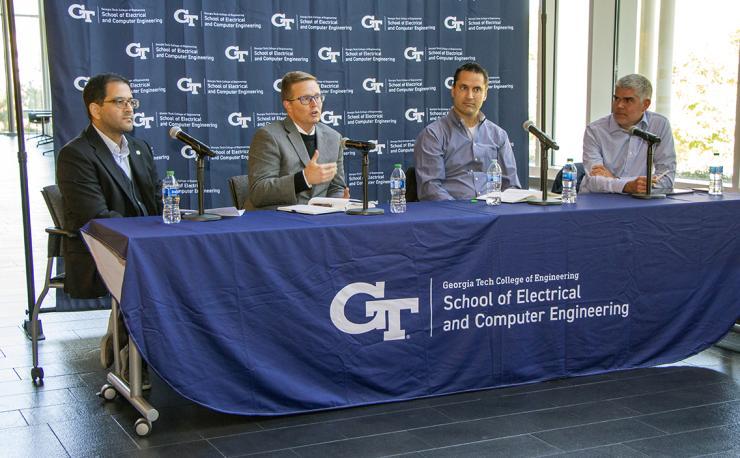
During the visit, SRC’s President and CEO, Todd Younkin (second from left), participated in an ECE Panel Discussion with Roland Sperlich (second from right) of Texas Instruments and Fernando Mujica (right) of Apple Inc. The panel, moderated by ECE Professor Muhannad Bakir (left).
The Georgia Tech School of Electrical and Computer Engineering (ECE) will be a significant contributor to overall success of the nation’s goal to increase domestic semiconductor production and solidify its microelectronics workforce as collaborative efforts by industry and government come into focus.
The School’s established partnership with the Semiconductor Research Corporation (SRC), in particular, will be key to the country’s long-term semiconductor competitiveness. As specific plans and investment opportunities continue to be developed, Dr. Todd Younkin, SRC’s CEO and President, visited the Georgia Tech campus in Atlanta on October 20-21. SRC is a world-renowned, high technology-based consortium that serves as a crossroads of collaboration between technology companies, academia, government agencies, and SRC’s highly regarded engineers and scientists.
“At this specific moment in time, when the county and world are committed to innovation in semiconductor technologies, it’s critically important to address our significant challenges strategically and collaboratively,” said Arijit Raychowdhury, the ECE Steve W. Chaddick School Chair. “Without the leadership of SRC, many challenges would go unmet. Having Todd on campus to meet with students, researchers, and leadership is fundamental to our future plans together.”
Younkin joined the ECE Advisory Board at the start of this fiscal year (July 1, 2022). At SRC he leads a ~$90 million per year global research agenda supported by over 3,000 academic and industrial researchers, 27 international companies, and three U.S. government agencies (DARPA, NIST, and NSF).
Currently Georgia Tech is a partner in SRC’s Joint University Microelectronics Program (JUMP). JUMP supports long-term research focused on high performance, energy efficient microelectronics for end-to-end sensing and actuation, signal and information processing, communication, computing, and storage solutions that are cost-effective and secure. The program, launched under the direction of Younkin in 2018, has six multi-university, multi-disciplinary innovation centers with 137 faculty, 749 students, and 412 industrial engineering liaisons.
“Georgia Tech offers a unique combination of expertise and collaborative spirit that is an important part of any SRC program.” Younkin said during his visit. “The faculty prepares future engineers to hit the ground running when they enter the semiconductor engineering workforce, either in academia or industry. This is crucial in the face of the rapid changes occurring in the microelectronics landscape today.”
Younkin also praised Georgia Tech’s unique fabrication and packaging facilities. Few universities can support the entire microelectronics stack – from materials and devices to packaging and systems – like Georgia Tech does.
Raheem Beyah, the dean of the College of Engineering and Southern Company Chair, and Chaouki T. Abdallah, executive vice president for research at Georgia Tech, met with Younkin during the visit. Additionally, Younkin was able to discuss ECE’s Opportunity Research Scholars’ Program (ORS), an innovative undergraduate research program designed to enhance and expand the academic experience of undergraduate students majoring in ECE, with academic professionals, faculty members, and the talented ORS student researchers.
On the afternoon of Oct. 20, Younkin participated in an ECE Panel Discussion with fellow Advisory Board member Roland Sperlich of Texas Instruments and Fernando Mujica of Apple Inc. The panel, moderated by ECE Professor Muhannad Bakir, attracted around 80 students. During the panel, Younkin expressed the demand for engineers with good communication skills and emphasized the importance of diversity.
“In order for companies to develop market-ready solutions, it’s crucial they are talking the same language,” said Younkin. “Additionally, the field needs to further prioritize diversity and inclusiveness. Achieving an inclusive workforce that unlocks the talents inherent in all of us requires increasing the participation of women and under-represented minorities, as well as striking a balance between American citizens and talented people coming from other nations.”
Last year, SRC and the Defense Advanced Research Projects Agency (DARPA) announced JUMP 2.0, a new long-term university research collaboration that will advance information and communication technologies (ICT) critical to the country’s economic growth and national security. The program signifies a new chapter in SRC’s history of public-private partnership with DARPA, leading semiconductor and ICT companies, and the defense industrial base.
Like its predecessor, JUMP 2.0 will work with researchers at outstanding U.S. universities – including Georgia Tech – to create collaborative, multidisciplinary research centers. SRC and DARPA look to announce the JUMP 2.0 research centers in early 2023.
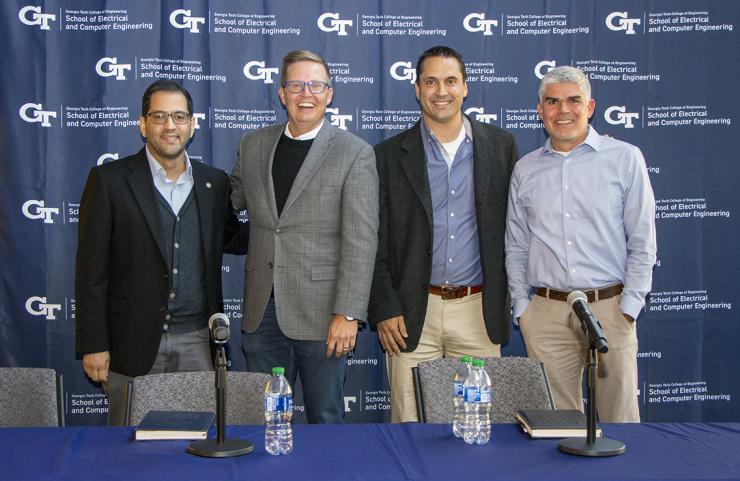
ECE Professor Muhannad Bakir, Todd Younkin of SRC, with Roland Sperlich of Texas Instruments and Fernando Mujica of Apple Inc.
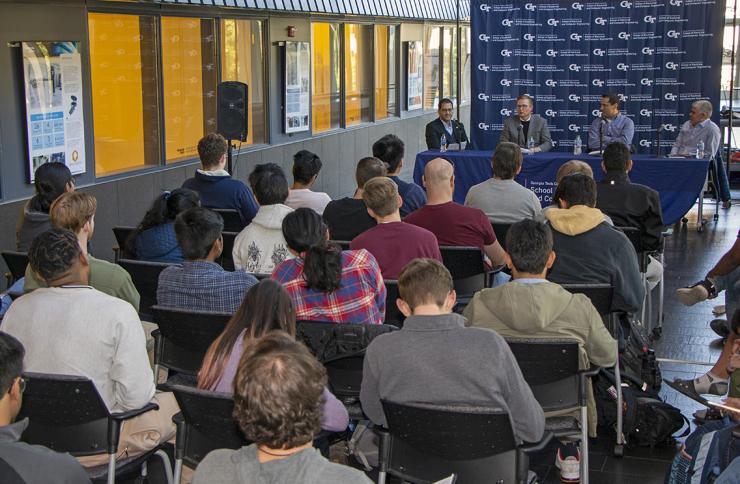
Nearly 80 ECE undergraduate and graduate students attended the ECE Panel Discussion on October 20.
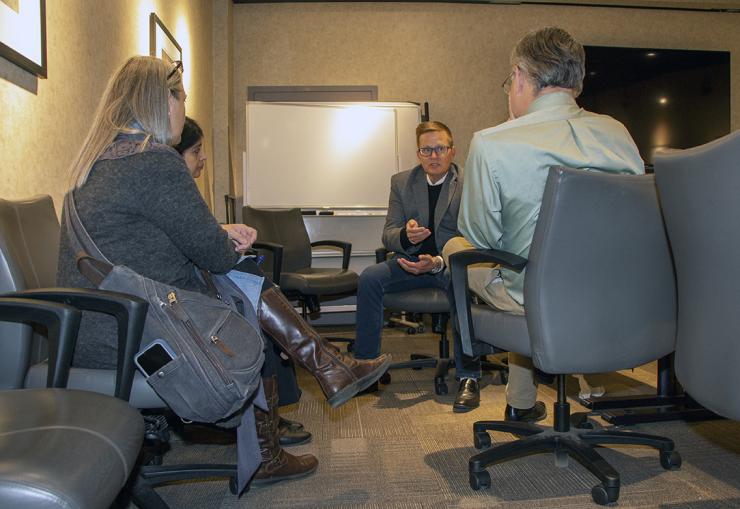
Todd Younkin, SRC’s President and CEO, discussing ECE’s Opportunity Research Scholars’ Program (ORS) with program leaders Greg Durgin (Faculty Director), Julie Ridings (Assistant Director), and Shanthi Rajaraman (Director).
Dan Watson
dwatson@ece.gatech.edu
2023 Southeast Regional Clinical and Translational Science Conference
Registration Required - Click HERE
Join the Georgia CTSA at Callaway Resort and Gardens as they bring together researchers from across the region to present the best new health-related preclinical, clinical, implementation, and population-based research and build collaborative relationships. Hosted by the Georgia CTSA, with participation from:
Materials Characterization Facility Open House
Materials Characterization Facility Open House
Monday, November 14
10:00 a.m. - 1:00 p.m. - Electron Microscopy
2:00 p.m. - 5:00 p.m. - X-Ray analysis
Tuesday, November 15
10:00 a.m. - 1:00 p.m. - Optical & X-ray Spectroscopy
2:00 p.m. - 5:00 p.m. - Open session
Vapor Cells for Quantum Sensors
Vapor cells for quantum sensors
Blowin' in the Wind
Oct 19, 2022 — Atlanta, GA
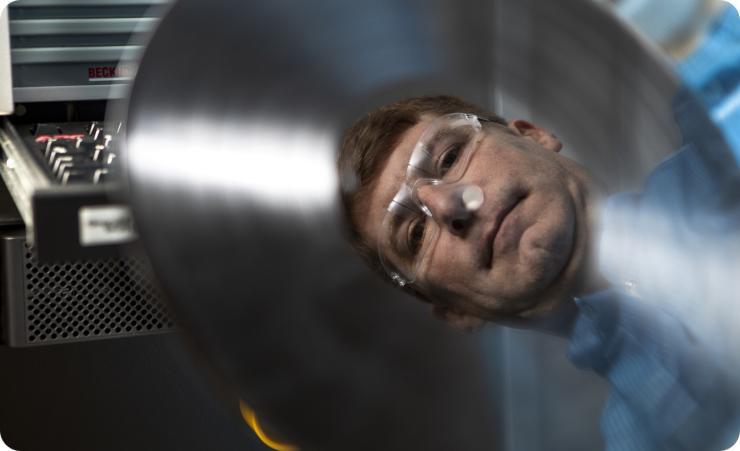
Jud Ready, a GTRI principal research engineer, worked with a team of artists and recording engineers to boost the quality of analog music reproduction through a new surface coating that both improves sound quality and prevents wear. Credit: Christopher Moore
As music distribution technology shifted from analog vinyl records to digital compact discs (CDs) and then to streaming files, the sound quality took a substantial hit – along with the monetary value of the musical consumer product.
Now, as the vinyl format is enjoying a comeback, materials scientists at the Georgia Tech Research Institute (GTRI) have worked with a team of artists and recording engineers to boost the quality of analog music reproduction through a new surface coating that both improves sound quality and prevents wear. The patented technology led to the creation of a one-of-a-kind Bob Dylan record that recently brought $1.8 million at a Christie’s auction.
A First for a New Generation of Discs
The studio recording of Dylan’s 1963 classic “Blowin’ in the Wind” is the first of a new generation of unique archival records with spectacular sound quality and the capacity for a thousand plays (or more) without deterioration. For musician and producer T Bone Burnett, the goal of the effort was to provide musical artists with a new medium – and an opportunity to set the value of their work themselves.
“Recording artists have had the value of what we do determined for us under the shorter and shorter-term technologies of mass production and distribution by organizations, governments, distributors, streamers, and others, but we have not had a way to find the value of an individual work of art,” said Burnett, a long-time Dylan collaborator who played guitar on the recording. “If we are able to help establish a music space in the fine arts through the making of these archival discs, musicians will be able to find real value for their work.”
Nanometer-Scale Coatings Improve Quality
The new record format, which Burnett has dubbed an “Ionic Original,” was made possible by a unique coating of sapphire and quartz applied to a layer of nitrocellulose on an aluminum disc. The coating was developed with help from GTRI materials scientists Jud Ready and Brent Wagner.
“We helped them develop a way to put a hard oxide coating on top of the nitrocellulose lacquer to protect it during play,” said Ready, a GTRI principal research engineer and deputy director of Georgia Tech’s Institute for Materials. “That includes silica (SiO2), better known as quartz, and alumina (Al2O3), which is known as sapphire. With other ingredients and variables, it’s a gradient designed to produce the best sound quality and resist the wear that would otherwise happen to the nitrocellulose acetate.”
A hard coating is needed because the stylus “needle” used to play the record on a conventional turntable can be made of diamond, which is even harder than quartz or sapphire. Playing a traditional vinyl record causes abrasion in the much softer grooves where the music is stored, causing wear that degrades the sound quality over time and also creates annoying pops and noise – issues that led to adoption of compact discs which are played with a non-contact optical reader.
The Analog Advantage
But digital formats – CDs and streaming files – provide listeners a digitally sampled version of the original analog sound rather than more fully reproducing what was created by the musicians. Though most consumers won’t notice, the difference can be heard – which helps account for the renaissance of analog records.
“Analog music travels in actual waves – not sampled and simulated – and sounds more resonant, deeper, and truer,” Burnett explained. “Analog records more atmosphere. It is closer to the human. An Ionic Original is the equivalent of a painting, hand-made and retouched by the artist. A digital stream is the equivalent of seeing a copy of a photograph of a painting.”
Subjecting the Research to the Turntable Test
In 2013, Ready and Wagner worked with Burnett and recording engineer Barak Moffitt to develop the coating technique, which was patented. The patent is now owned by Ionic Recording Company LLC, which bought it from Georgia Tech. Separate from the original work that led to the patent, Ready more recently worked as a private consultant with Ionic to support refining the new process and identifying a company that could coat the record.
“The issues were in the thin film coatings – the time, the density of the coating, the ratio between the two elements – and the pre-cleaning process before the coating was put down,” Ready explained.
Ahead of the quartz-sapphire coating process, production of the record proceeded much like any other analog record. Dylan recorded the song in 2021; it was mixed in Los Angeles and Nashville, and finally mastered in Memphis by Jeff Powell, one of the world’s top vinyl cutting experts.
“When an artist like Bob Dylan, a producer like T Bone Burnett and a recording engineer like Mike Piersante went into a project like this, they knew the desired result was a pristine vinyl master lacquer that would go through the Ionic coating process and sound as good or better than any vinyl record ever made even after 1,000 plays,” said Powell.
Several 10-inch-diameter discs were made and compared by Piersante, who graded them all on a scale of zero to 10. The best one was sent to Virginia-based Blue Ridge Optics for application of the thin-film coating. After that, the disc flew by private jet to California, where it was analyzed acoustically and presented to the media. Finally, it went on to London for the Christie’s auction.
An Eye-Opening Experience for a Materials Engineer
Ready’s bread-and-butter research involves thin-film coatings, but this is his first foray into the entertainment industry.
“We would normally put these down for optical coatings and to protect microelectronic devices,” Ready explained. “It’s a hundred nanometers or so of silica and alumina – a nanometer is a billionth of a meter – to create the scratch-resistant coating. At GTRI, we apply these coatings with a commercial-scale tool that is commonly used to put anti-reflective coatings on eyeglasses and on equipment used in space.”
Working as a consultant, Ready visited Burnett’s studio to compare the sound of the same song played from magnetic tape, vinyl, CD and finally, streaming files.
“The amount of resolution that goes away is incredible,” he said. “Whole instruments disappear. You could hear the faintest of different sounds on the tape and vinyl – but they were gone. There are ways that the CD recording is taking the sinusoidal analog waves and breaking them into lots of little rectangles. No matter how skinny you make the rectangle, you are always going to be losing some sound or adding noise.”
“Blowin’ in the Wind” Could Make New Waves
The 2021 Bob Dylan recording of “Blowin’ in the Wind” was just the second ever to be made in the studio. Written by the artist in 1962 and released on The Freewheelin’ Bob Dylan in 1963, it is a protest song that asks a series of questions about peace, war, and freedom. The song has been inducted into the Grammy Hall of Fame and, in 2004, was ranked 14th on Rolling Stone magazine's list of the "500 Greatest Songs of All Time."
What’s next for the process? Burnett believes the technique may generate interest among music archivists who may want to store recordings protected from wear. He promises there will be more one-of-a-kind records, including “several” additional Dylan cuts.
“We are speaking with interested people about private sales, and with other artists about making further Ionic discs,” he said. “Perhaps there will be other auctions. We remain open to seeing where this path leads.”
Writer: John Toon
GTRI Communications
Georgia Tech Research Institute
Atlanta, Georgia USA
About GTRI: The Georgia Tech Research Institute (GTRI) is the nonprofit, applied research division of the Georgia Institute of Technology (Georgia Tech). Founded in 1934 as the Engineering Experiment Station, GTRI has grown to more than 2,800 employees, supporting eight laboratories in over 20 locations around the country and performing more than $700 million of problem-solving research annually for government and industry. GTRI's renowned researchers combine science, engineering, economics, policy, and technical expertise to solve complex problems for the U.S. federal government, the state, and industry. For more information, please visit www.gtri.gatech.edu.
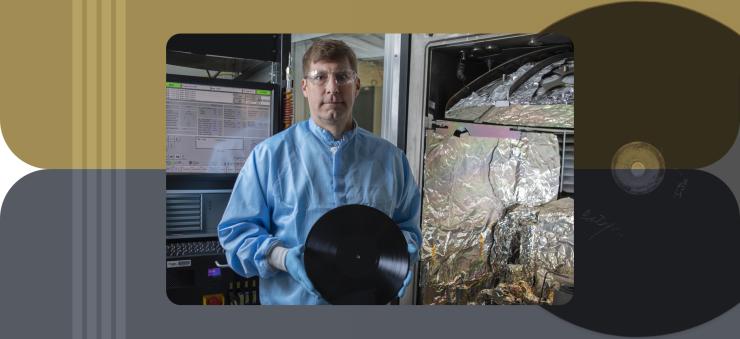
GTRI researchers used this equipment to apply wear-resistant coatings. Shown is Jud Ready holding an acetate of the type used in the research. Credit: Christopher Moore
(Interim) Director of Communications
Michelle Gowdy
Michelle.Gowdy@gtri.gatech.edu
404-407-8060
Datta Receives VLSI Technology and Circuits Test of Time Award
Oct 18, 2022 — Atlanta, GA
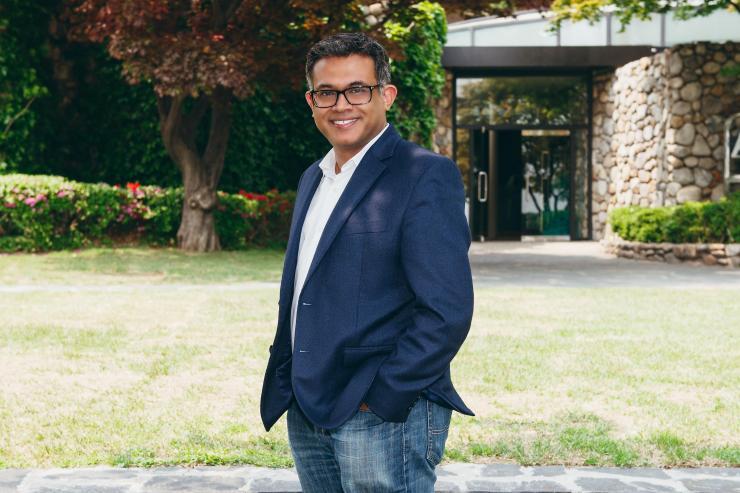
Suman Datta, Joseph M. Pettit Chair and a Georgia Research Alliance (GRA) Eminent Scholar
Suman Datta has received the Test of Time Award at the 2022 IEEE Symposium on VLSI Technology and Circuits. Datta is the Joseph M. Pettit Chair in Advanced Computing in the Georgia Tech School of Electrical and Computer Engineering (ECE) and a Georgia Research Alliance Eminent Scholar.
Datta, who holds a joint appointment with the School of Materials Science and Engineering, was honored this year along with his co-authors and former colleagues at Intel Corporation for his 2006 research, “Tri-Gate Transistor Architecture with High-k Gate Dielectrics, Metal Gates and Strain Engineering.” True to its name, the Test of Time Award recognizes papers that have established their significance in history by standing the test of time. The goal of the award is to honor impactful papers and promote their recognition in the Symposia’s community.
As transistor gets smaller, it gets harder to switch off the transistor effectively. In response, Datta and his former Intel colleagues formulated the Tri-Gate transistor technology that was first introduced commercially at the 22-nm technology node. The transistor architecture has scaled to the 5-nm node and remains the workhorse of all leading-edge logic technology.
The research was the first experimental demonstration of high-performance NMOS and PMOS Tri-gate transistors in which the channel strain, high-k gate dielectric, gate electrode work functions, epitaxial source-drain regions were co-optimized together with the fin dimensions (width and height) and the fin shape (trapezoidal versus rectangular). The paper illustrated how to combine the electrostatic benefit of the fully-depleted nonplanar transistor structure with high-permittivity gate dielectric, work-function engineered metal gate electrodes and high- strain-engineered high-mobility channel to demonstrate high-performance CMOS transistors.
In addition to receiving the Test of Time Award at the symposium, Datta organized a short course on Monolithic and Heterogenous Integration and Advances in Application-Specific Computing Systems and Technologies. His research group presented three papers at the symposium on A Thousand State Superlattice Ferroelectric Field Effect Transistor Analog Weight Cell (with Professor Shimeng Yu); BEOL Compatible Ferroelectric Routers for Run-time Reconfigurable Compute-in-Memory Accelerators (with Professor Shimeng Yu) and Multi-bit per-cell 1T SiGe Floating Body RAM for Cache Memory in Cryogenic Computing (with Professor Arijit Raychowdhury).
Now in it’s 42nd year, the IEEE Symposium on VLSI Technology and Circuits is known as the microelectronics industry’s premiere international conference integrating technology, circuits, and systems. The 2022 symposium convened this year in Honolulu, Hawaii.
Dan Watson
dwatson@ece.gatech.edu
Engel Recognized for Semiconductor Research at ICMBE
Oct 13, 2022 — Atlanta, GA
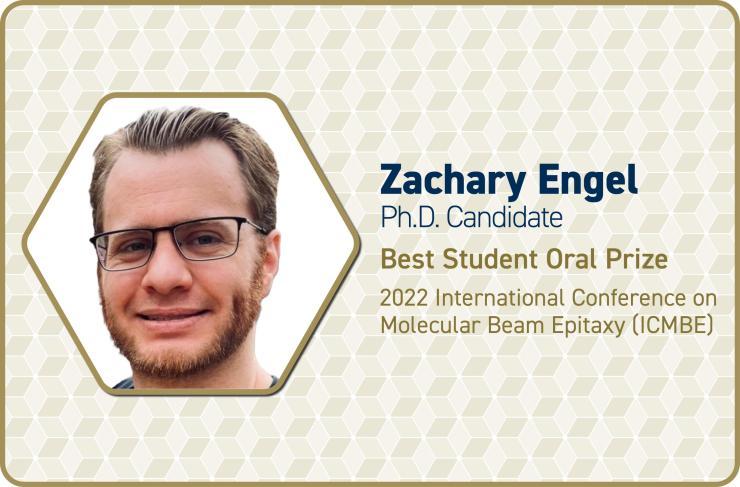
Zachary, a Ph.D. candidate in the Georgia Tech School of Electrical and Computer Engineering
Zachary Engel has won the Best Student Oral Prize at the 2022 International Conference on Molecular Beam Epitaxy (ICMBE). Engel is a Ph.D. candidate in the Georgia Tech School of Electrical and Computer Engineering (ECE) and is part of ECE’s Advanced Semiconductor Technology Facility (ASTF) directed by Professor Alan Doolittle.
ICMBE recognized Engel for the quality of his work and presentation excellence on "Demonstration of Sc0.2Al0.8N HEMT structures with a sheet resistance of 150 Ω/□ and a sheet charge of 5.9x1013 cm-2 with phase pure, metal rich growth.”
The research presents new semiconductor chemistries that allow for improved semiconductor quality as demonstrated by a record sheet charge and channel resistance in a next generation replacement for the current champion of power and RF transistors, AlGaN/GaN transistors. This new device will allow 2.5 times higher current than present technologies. In principle, it can be integrated with ASTF’s groundbreaking aluminum nitride-based semiconductor, which previous demonstrations have shown to be the largest voltage semiconductor ever created.
This year’s ICMBE was held in Sheffield, United Kingdom from September 4-9. The conference began in 1978 in Paris, France and provides a prominent international forum for reporting new developments in the areas of fundamental and applied molecular beam epitaxy research, including advances in the technique, synthesis of new materials, discovery of new physical properties, formation of novel heterostructures, and the development of innovative devices.
Dan Watson
dwatson@ece.gatech.edu
ECE Panel Discussion - Hardware Research and Education
Hardware Research and Education
Date: Thursday, October 20, 2022
Time: 2:30 p.m. - 4:00 p.m.
Location: Marcus Nanotechnology Building - Atrium
Featuring:
-
Roland Sperlich
Vice President and General Manager for Interface Products
Texas Instruments -
Todd Younkin
President and CEO
Semiconductor Research Corporation
Moderated by Dr. Muhannad Bakir, Dan Fielder Professor
UpNano NanoOne Seminar
UpNano NanoOne Seminar
Join us to learn about the NanoOne, the fastest high-resolution 3D printing system on the market.
UpNano manufactures and sells high resolution 3D printers under the NanoOne platform which are capable of printing parts with a wide range of volumes (100 – 1012 mm3) at unmatched speed.
Kwong using NIH Director's Pioneer Award to Develop Living Biosensors
Oct 05, 2022 — Atlanta, GA
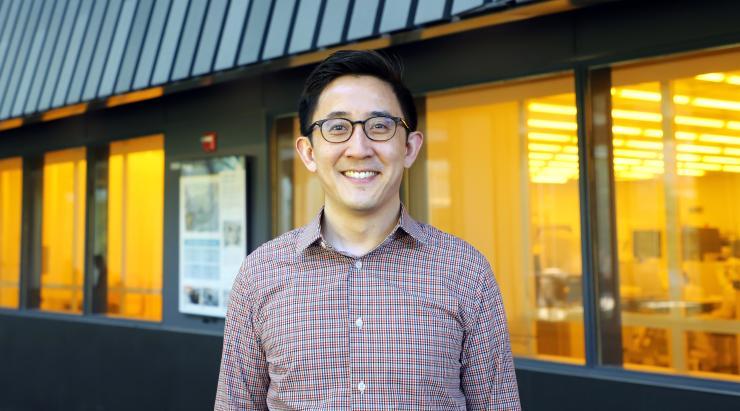
Gabe Kwong won the NIH Director's Pioneer Award.
Some cancers have a long and deadly memory. Years or decades after the disease has been beaten into remission, cancer cells that weren’t killed by initial treatment may be lying dormant at metastatic sites, like the bone marrow, until they reawaken with malignant intent.
Gabe Kwong wants to build living sentinels to detect those dormant and potentially deadly disseminated tumor cells (DTCs) before the cancer can recur. It’s an ambitious and groundbreaking idea from a researcher whose lab has developed a reputation for innovative work, and it’s earned Kwong a 2022 Director’s Pioneer Award from the National Institutes of Health (NIH).
“I’m extremely humbled, and grateful for what this means for the lab,” said Kwong, associate professor in the Wallace H. Coulter Department of Biomedical Engineering at Georgia Tech and Emory University. “This is a peer-reviewed honor, and it tells us that the field recognizes that our work over the past 10 years has been impactful and worth investing in.”
The Pioneer Awards support highly creative researchers with potentially transformative ideas. The largest grant in the NIH’s High-Risk, High-Reward Research program, the award will provide Kwong $5.5 million over the next five years. This is the first time a Georgia Tech or Emory research has received funding through the program. And it’s Kwong’s second high-risk project funded: He won the NIH Director’s New Innovator Award for early career scientists in 2016.
According to the NIH, proposed pioneering work must be high-impact and “reflect ideas that are substantially different” from the researcher’s current program. Kwong’s lab has been focused on engineering synthetic sensors until now. With this project, he’s shifting to reengineering living cells.
“For years, we’ve been designing ultra-sensitive sensors to detect cancer or the response to immunotherapy drugs. They function as sentinels and report on sites of disease by producing a signal that can be detected from a biofluid such as urine,” he said. “They’ve been inorganic probes that don’t have a memory or know how to think. Our goal is to develop a living sensor — immune cells that can traffic through the body and act as a long-lived pool of sentinels.”
Kwong is driven by the potential threat of cancer dormancy. Many cells leave the primary tumor and enter the body’s circulation. Called circulation tumor cells, or CTCs, they are typically short-lived and don’t lead to metastasis. Sometimes, however, a few of these cells may find their way to a distant organ and hide there, despite seemingly successful cancer treatment. These cells can wait for years, or even decades, before reawakening. So, patients with no evidence of disease could harbor dormant cancer and remain at risk of metastatic relapse for the rest of their lives.
“Currently, there is no good way to monitor these dormant cells or their reawakening,” Kwong said. “But we are living in an entirely new era of medicine and cancer immunotherapy where we can design T cells as living medicines. We see this as an opportunity to not only build a future where immune cells are engineered as therapies, but also as living sensors.”
The idea is to use the same T cells that are grafted into a patient as cancer-fighters as lifelong sensors that are continuously on the lookout for future disease. If Kwong and his team are successful, he said the technological breakthroughs could lead to new about how and when dormant cells reawaken.
“Once we figure out how to engineer these cells, we’ll likely transition to a phase where we’re talking more about earlier detection and preventative medicine,” he said. “Our new drugs are already working much, much better than before. Imagine if we can keep the cancer from coming back for years and years and intervene at the earliest stages of recurrence. That’s the high reward.”
